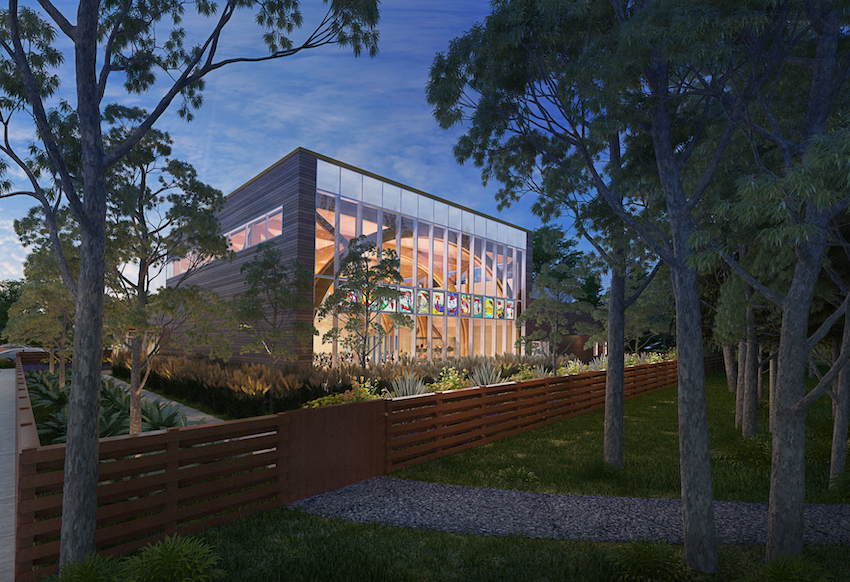Wood Structures: An Impressive Renewable Resource
Learning Objectives:
- Explain the focus of the overall design process for each project.
- Describe the design constraints of the Temple Beth Tzedek project.
- List two strategies used for the University of Arkansas project to reduce its carbon footprint.
- Discuss the benefits each project achieved working with glulams.
Credits:
This webinar is part of the Wood Structures Academy.
The Temple Beth Tzedek, a 10,000-square-foot new construction in Amherst, New York, provides gathering space, administrative areas, and a new 300-seat sanctuary for the congregation. Working with glue-laminated wood fabricators (glulams), the sanctuary space is framed by five large arches (bents) that span 55 feet clear, creating the generous volume for the 3,000-square-foot area. Rebecca Berry of Finegold Alexander Architects and Ryan Sieber of LA Fuess coordinated closely on scale of members, wood specie, wood finish, and the specifications of metal connectors and visible bolts at the bents. The completed project showcases the outdoor woods framed by the sanctuary arches and the texture of natural wood and light.
The Stadium Drive Residence Halls project at the University of Arkansas is the nation’s first large-scale mass timber student residence at 202,027 sf. The project aspired to realize the environmental, economic, and aesthetic benefits of mass timber construction, reducing the university’s carbon footprint and stimulating further development of the regional timber industry. To meet this challenge, Ashley Rao, AIA, LEED AP, Leers Weinzapfel Associates (Boston), applied advanced timber technologies such as Cross Laminated Timber (CLT) panels, as well as glulam beams and columns for the buildings’ structures. The project is targeting LEED certification and is expected to be completed later this year. Working on the project alongside Leers Weinzapfel Associates, is Modus Studio, Mackey Mitchell Architects, and OLIN.
The presentations will be followed by a moderated discussion focused on how these distinctive wood projects address several key issues, including:
- Cost: What tradeoffs, if any, are required to achieve contemporary design excellence, particularly in terms of using energy-efficient, sustainable materials, products, and practices for the optimization of the designs? In the featured projects, what was the ultimate value in the specific design decisions?
- Aesthetics: What role did the desire for a particular aesthetic play in determining the scope and main features in the designs? What were the results of those decisions? What were the obstacles?
- Drivers:Did the clients request certain features, or did you, as the architects, propose them? If the latter, what led you to suggest using specific materials or make specific design decisions to support the end goal? How did occupant satisfaction goals inform design decisions?
- Design Constraints and opportunities:What were some of the unique constraints of the projects, and what opportunities did they create for innovative design?

Photo courtesy of Finegold Architects
 |
Rebecca Berry, AIA, LEED AP BD+C, is president of Finegold Alexander Architects. She has more than 15 years of experience managing a variety of higher-education, civic, and residential projects, including Boston University’s Kilachand Hall, the Alice K. Wolf Center in Cambridge, the Royal luxury housing in Boston, and the B’nai Jehoshua Beth Elohim Synagogue in Deerfield, Illinois. Rebecca is a volunteer and former Americorps member, and she has served as a designer and construction supervisor with Habitat for Humanity in the United States and abroad. She holds a Bachelor of Science in art and design, a Bachelor of Science in political science, and Master of Architecture from Massachusetts Institute of Technology, where she received the Alpha Rho Chi medal, a national award in recognition for service. Rebecca is a Registered Architect and LEED Accredited Professional, and she received the 2014 Banker + Tradesman – Women of Fire award. |

|
Ashley Rao, AIA, LEED AP, is an associate with Leers Weinzapfel Associates in Boston. Recipient of the AIA Architecture Firm Award, the practice is known for its distinguished work in complex academic and infrastructure projects and leadership in mass timber design. As project architect and project manager, Ashley led the design team for the University of Arkansas Stadium Drive Residences, a 708-bed, 202,000-square-foot new dormitory complex currently under construction in Fayetteville, Arkansas, the largest project in the United States to be constructed using advanced timber technology. A graduate of Harvard University with a Master of Architecture from Yale University, Ashley is passionate about creating vibrant, sustainable buildings and urban environments, speaking nationally at seminars and on webinars about mass timber design. |

|
Ryan Sieber is an experienced project manager that began his structural engineering career at L.A. Fuess Partners in 2010 after graduating from MIT with a Master of Engineering degree. He has designed structural systems utilizing concrete, steel, and wood for a wide variety of project types, including higher education, office, retail and mixed-use, multifamily residential, and historic renovation and adaptive reuse projects. Now a senior associate at the firm, Ryan is responsible for managing the successful completion of projects from design through construction, and he aims to deliver high-quality projects that are on point with clients’ needs and creative visions. For the Temple Beth Tzedek project, his design expertise and project management efforts were instrumental in the overall structural success of the project. |








